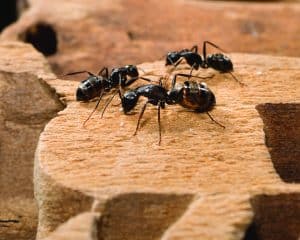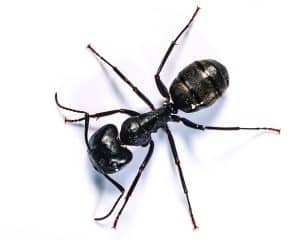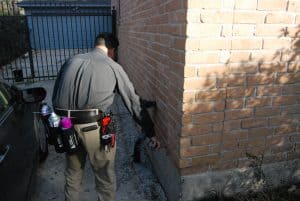Carpenter Ants
Carpenter Ants
Carpenter ants are the second most destructive pest against your home, next to termites. Carpenter ants have been around for thousands of years, attacking many different types of wood, both inside the home, and outside the structure.
What is interesting, is that carpenter ants, unlike termites, don’t actually eat the wood. They “carve” out holes in the wood, to find a safe place to lay their eggs and raise their colony. But this can be just as bad as termites that eat the wood.
Carpenter ant “teeth” or mandibles, are very powerful. They rip apart the fibers of the wood, bit by bit, until many different tunnels are created and serve as safe places to raise their offspring. What makes this even worse, is that carpenter ants will continue this destruction of the wood generation after generation, if left untreated.
When it comes to exterminating carpenter ants in and around your home we always want to come out and do an ant inspection. Our professional technicians will be able to identify the type of ant and also the entry point and nest location. From there our staff will communicate our recommendations for eradicating them. We will also communication any necessary prevention strategies that should be addressed to prevent a reinfestation.
What Do Carpenter Ants Look Like?

What Carpenter Ants Look Like
Carpenter ants can vary in size and can range from about ½ inch to upwards of ⅝ inch. The black carpenter ant is by far the most common ant found, but they can be a combination of reddish brown in color also.
Black Carpenter Ants in Texas
Carpenter can ants live up to a year, and have many offspring. These new ants, will continue the excavation process in the existing structure, until there is no longer enough wood left to build tunnels in.
The wood in the structure, or outside, will become very brittle and unsound due to all the tunnels and galleries that have been created.
Carpenter ant damage might go unseen, and they move throughout the inside of the wood.

Signs of an Infestation
However, you can tell if you have a carpenter ant problem or infestation and how to find out how they have entered a home by a few different signs.

Have a Carpenter Ant Inspection
Evidence of carpenter ants, the first way to tell if you have a carpenter ant problem is by seeing the ants themselves.
Carpenter ants in Kingwood and surrounding areas are typically 2 different types. There are either very large all black ants, or medium sized red and black ants. Both of these ants are active both inside the home and out. They are capable of nesting in the landscape in some old timbers, a nearby tree, or in the structure.
The second way to tell if you have a carpenter ant problem is to see the evidence they leave behind. Quite often, there will be debris called “frass”. Frass is a mixture or combination of sawdust from the chewing, insect body parts, and shed skins. It can also consists of any other nesting materials the carpenter ants have dug through. As mentioned earlier, carpenter ants don’t eat the wood.
They eat other insects. There is typically left over body parts when they feed on other critters, and this, in combination with nesting material, makes up frass. Frass is typically found on the window sill, in the attic, and on the floor. It is kicked out of the wood the ants are nesting in, so where you see frass, the infestation source is not far.
The last way to tell if you have carpenter ant infestation is by hearing them, a rustling sound can be heard. Because carpenter ants are large, especially the ones in the Kingwood and surrounding areas, you can actually hear them in the walls voids and attic.
Typically they are most active at night, and it sounds like scurrying around in the walls and wall voids. This is a tell tale sign you have carpenter ants. The only other insect you would typically hear making a similar sound is carpenter bees, but that is a whole other topic!

Do Carpenter Ants Bite?
Yes, they do have very powerful jaws and the bite can be pretty painful. You can also feel a burning sensation after the bite, because they can inject formic acid in to the bite area.
Fortunately, all this will pass and carpenter ants do not cause any real health risk.
FullScope Pest Control can eliminate your carpenter ant problem.
Signs of an Infestation
Ants, as a family of insects, are amazingly diverse and highly adaptive. Entomologists believe that 50,000 years ago, ants were the first farmers. Leaf cutter ants use cut-outs from leaves to grow a very special fungus, which they eat.
Most homeowners are not bothered by leaf-cutter ants; they are bothered by carpenter ants. A misnomer about carpenter ants is that they do eat wood. They are carnivores and are often drawn to homes because of pet food or an area that has a constant moisture issue, making excavation easy.
How do you get rid of carpenter ants? There are a couple of options that are perfect and work specifically for carpenter ants.
Professional Pest Control Sprays and Carpenter Ant Baits
Contact insecticides work with carpenter ants, but they do not always solve your ant problem. If you want to get rid of ants at their source, an easy weapon is to use bait. Ants are highly social insects, so ant baits that offer a slow kill help to spread the insecticide throughout the colony and to the ant queen. This is the best option for carpenter ant extermination, because it works to eliminate the ants you see and the one you do not.
They are very communal, and they have very specific roles that they play in their colonies. Foragers, which are the ants you see around your pets food dishes, have the sole task of hunting for and bringing food back to the nest. That is why bait works well on ants.
Carpenter Ants helpfully pick up the bait and return it to the nest where it begins to poison the ants at their source.
Sprays work well to keep foraging ants out of your house. If you consider how ants work, then you should know that a multi-step approach works best.
-

Bait works to get rid of ants that you currently have
-

Spray insecticides and granules work to keep foraging ants at bay.
The thing to consider is that once the forager ant discovers a food source, they alert all of their sisters to its location so that all of the ants can come and collect the food. Spray, granules, and gel help stop the messenger from giving that message. Without a message, the hoard does not show up at your home.
Continual usage of these products helps deter ants from returning. Products that are non-repelling insecticides, and this means that the ants cannot sense that you have applied a chemical so they will continue to move around as if there was nothing there and the chemicals fipronil is shared with the entire colony for total elimination.

If your home seems to be attracting carpenter ants, FullScope has ways to help you win the battle for your home. For other types of ant problems, or if you are not sure which type of ant is invading your home, our staff is willing to help. Generalized products can work too, but understanding how the ant behaves is a key to controlling them successfully.
We have the knowledge and expertise to assist you in controlling and eliminating your carpenter ant problems, call us today for a free estimate. We are here to help with all of your pest control needs.
So trust your neighborhood carpenter ant exterminators to use the best products in the right location to eliminate them from your home and yard for good!
